| Transcriber's Note: [p] or [P] represents a turned p or P. [T] represents a turned T. |
OMAHA DWELLINGS, FURNITURE, AND IMPLEMENTS
BY
JAMES OWEN DORSEY
CONTENTS
| Page | |
| Introductory note | 269 |
| Dwellings | 269 |
| Earth lodges | 269 |
| Lodges of bark or mats | 271 |
| Skin lodges or tents | 271 |
| Furniture and implements | 275 |
| Fireplaces | 275 |
| Beds and bedding | 275 |
| Cradles | 275 |
| Children's swings | 276 |
| Brooms | 276 |
| Pottery | 276 |
| Mortars and pestles | 276 |
| Spoons, ladles, and drinking vessels | 277 |
| Water vessels | 277 |
| Other vessels | 277 |
| Hoes and axes | 278 |
| Knives | 278 |
| Implements connected with fire | 279 |
| Smoking paraphernalia | 279 |
| Equipage for horses | 280 |
| Traveling gear | 281 |
| Boats | 281 |
| Musical instruments | 281 |
| Weapons | 283 |
| Clubs | 283 |
| Tomahawks | 284 |
| Spears | 284 |
| Bows | 285 |
| Arrows | 286 |
| Quivers | 287 |
| Shields and armor | 287 |
| Firearms | 288 |
ILLUSTRATIONS
| Page | ||
| Fig. | 306. Yellow Smoke's earth lodge | 270 |
| 307. Ground plan of Osage lodge | 271 | |
| 308. Omaha tent | 272 | |
| 309. Exterior parts of an Omaha tent | 273 | |
| 310. [P]ejequde's tent | 274 | |
| 311. Omaha cradle—plan | 276 | |
| 312. Omaha cradle—side view | 276 | |
| 313. Omaha mortar | 277 | |
| 314. Omaha pestle | 277 | |
| 315. Omaha calumet | 279 | |
| 316. Omaha pipe used on ordinary occasions | 280 | |
| 317. Skin drum | 282 | |
| 318. Box drum | 282 | |
| 319. Omaha large flute | 283 | |
| 320. Omaha club (jan-[p]aɔna) | 283 | |
| 321. Omaha club (jan-[p]aaɔna) | 283 | |
| 322. Omaha club (weaqȼade) | 284 | |
| 323. Omaha bow (zanzi-mandĕ) | 285 | |
| 324. Omaha bow (ʇaʞan-mandĕ) | 285 | |
| 325. Omaha hunting arrow | 286 | |
| 326. Omaha war arrow | 286 | |
| 327. Omaha style of hidé-ʇáce | 286 |
OMAHA DWELLINGS, FURNITURE, AND IMPLEMENTS
BY JAMES OWEN DORSEY
INTRODUCTORY NOTE.
The accompanying paper is one of the results of personal investigations among the Omaha of Nebraska and cognate tribes of Indians, beginning in 1878 and continued from time to time during late years.
While the paper treats of the Omaha tribe, much that is said is applicable to the Ponka, as the two tribes have long had similar environments and a common dialect, for, until 1877, their habitats were almost contiguous, and since 1880 about one-third of the Ponka tribe has been dwelling on its former reservation near the town of Niobrara, Nebraska.
Acknowledgments are due Dr. O. T. Mason for many valuable suggestions early in the progress of the work.
DWELLINGS.
The primitive domiciles of the Omaha were chiefly (1) lodges of earth or, more rarely, of bark or mats, and (2) skin lodges or tents. It may be observed that there were no sacred rites connected with the earth lodge-building or tent-making among the Omaha and Ponka.
Earth Lodges.
When earth lodges were built, the people did not make them in a tribal circle, each man erecting his lodge where he wished; yet kindred commonly built near one another.
The earth lodges were made by the women, and were intended principally for summer use, when the people were not migrating or going on the hunt. Those built by the Omaha and Ponka were constructed in the following manner: The roof was supported by two series of vertical posts, forked at the top for the reception of the transverse connecting pieces of each series. The number in each series varied according to the size of the lodge; for a small lodge only four posts were erected in the inner series, for an ordinary lodge eight were required, and ten generally constituted the maximum. When Mr. Say1 visited [Pg 270] the Kansa Indians, he occupied a lodge in which twelve of these posts placed in a circle formed the outer series, and eight longer ones constituted the inner series, also describing a circle. The wall was formed by setting upright slabs of wood back of the outer posts all around the circumference of the lodge. These slabs were not over 6 feet in height, and their tops met the cross timbers on which the willow posts rested. Stocks of hard willow about 2 inches in diameter rested with their butts on the tops of the upright slabs and extended on the cross timbers nearly to the summit. These poles were very numerous, touching one another and extending all around in a radiating manner, supporting the roof like rafters. The rafters were covered with grass about a foot thick; and over the whole lodge, including the sides or slabs, earth was piled from a foot to 2 feet in depth. Such a covering lasted generally about twenty years. A hole in the middle served as an exit for the smoke.
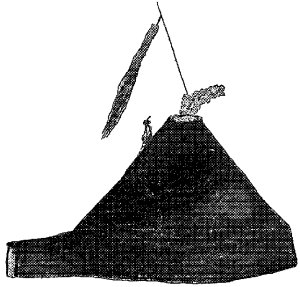 Fig. 306.—Yellow Smoke's earth lodge.
Fig. 306.—Yellow Smoke's earth lodge.
In addition to the lodge proper there was a covered way about 10 feet long and 5 feet wide, the entrance to which had a covering of tanned or dried buffalo hides. This covering consisted of two hides hanging side by side, with the inner borders slightly overlapping. They were fastened to the passageway at the top and at the outer sides, but were loose at the bottom where they overlapped. This part was raised by a person entering the lodge. A similar covering was placed at the interior end of the passageway.
Subsequently to 1855, the Omaha dwelt in three villages composed of earth lodges, as follows: (1) Biku′de, a village near the agency; (2) Windja′ge, Standing Hawk's village, near the Presbyterian mission house; and (3) Janȼa′te ("Wood Eaters,") named after an insect found [Pg 271] under the bark of trees Sanssouci's village, near the town of Decatur, Nebraska.
Earth lodges were generally used for large gatherings, such as feasts, councils, or dances. Occasionally there was a depression in the center of the lodge which was used as a fireplace; but it was not over 6 inches deep. Each earth lodge had a ladder, made by cutting a series of deep notches along one side of a log. On a bluff near the Omaha agency I found the remains of several ancient earth lodges, with entrances on the southern sides. Two of these were 75 feet and one was 100 feet in diameter. In the center of the largest there was a hollow about 3 feet deep and nearly 4 feet below the surface outside the lodge.
1 James' account of Long's Expedition to the Rocky Mountains in 1819-'20.
Lodges of Bark or Mats.
The Omaha sometimes make bark lodges for summer occupancy, as did the Iowa and Sak. [T]iu′ȼipu jiñ′ga, or low lodges covered with mats, were used by the Omaha in former days. Such lodges are still common among the Winnebago, the Osage, and other tribes. The ground plan of such a lodge forms an ellipse. The height is hardly over 7 feet from the ground. The tent poles are arranged thus: Each pole has one end planted in the ground, the other end being bent down and fastened to the pole immediately opposite; a number of poles thus arranged in pairs formed both wall posts and rafters.
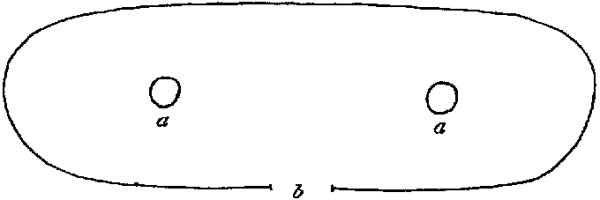 Fig. 307.—Ground plan of Osage lodge.
Fig. 307.—Ground plan of Osage lodge.
Generally there was one fireplace and one smokehole in such a lodge; but when I visited the Osage in 1883, I entered a low lodge with two fireplaces, each equidistant from its end of the lodge and the entrance, each fireplace having its smokehole.
Skin Lodges or Tents.
The tent was used when the people were migrating, and also when they were traveling in search of the buffalo. It was also the favorite abode of a household during the winter season, as the earth lodge was generally erected in an exposed situation, selected on account of comfort in the summer. The tent could be pitched in the timber or brush, or down in wooded ravines, where the cold winds never had full sweep. Hence, many Indians abandoned their houses in winter and went into their tents, even when they were of canvas.
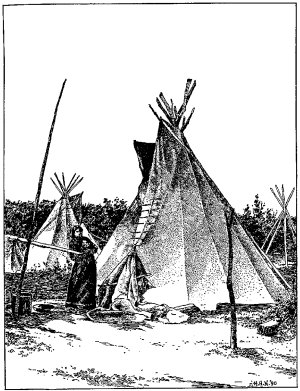 Fig. 308.—Omaha tent (from a photograph by W. H. Jackson).
Fig. 308.—Omaha tent (from a photograph by W. H. Jackson).
The tent was commonly made of ten or a dozen dressed or tanned buffalo skins. It was in the shape of a sugar loaf, and was from 10 to [Pg 272] 12 feet high, 10 or 15 feet in diameter at the bottom, and about a foot and a half in diameter at the top, which served as a smokehole (ʇihuʞan). Besides the interior tent poles (ʇici—3, figure 309) and the tent skin (ʇiha—1), the tent had the ʇiȼumanhan, or the place where the skins were fastened together above the entrance (4). The ʇiȼumanhan was fastened with the ʇihuȼubaxan(5), which consisted of sticks or pieces of hide thrust crosswise through the holes in the tent skins. The bottom of the tent was secured to the ground by pins (ʇihuȼugadan—6) driven through holes (ʇihugaqȼuge) in the bottom of the skins, made when the latter were tanned and before they had become hard. The entrance (ʇijebe) was [Pg 273] generally opposite the quarter from which the wind was blowing. A door flap (ʇijebegȼan—7) hung over the entrance; it was made of skin with the hair outside, so as to turn water, and was held taut by a stick fastened to it transversely. The bottom of the door flap was loose, but the top was fastened to the tent.
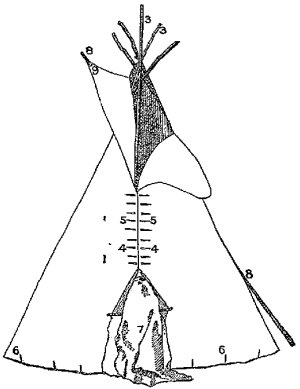 Fig. 309—Exterior parts of an Omaha tent.
Fig. 309—Exterior parts of an Omaha tent.
The smokehole was formed by the two ʇihugabȼinȼa(9), or triangular ends of tent skins, immediately above the entrance and ʇi¢umanan. When there was no wind both of the ʇihugabȼinȼa were kept open by means of the ʇihuȼubajin(8) or exterior tent poles, which were thrust through the ujiha, or small sacks, in the corners of the ʇihugabȼinȼa. When the wind blew one of the ʇihuȼubajin was raised to the windward and the other was lowered, pulling its skin close to the tent and leaving an opening for the escape of the smoke; but if the wind came directly against the entrance both the flaps were raised, closing the smokehole to prevent the wind from blowing down it. When the wind blew the people used nandiȼagaspe to keep the bottom of each tent skin in place. These consisted of twisted grass, sticks, stones, or other heavy objects.
Figure 310 represents the tent of [P]ejequde, an Omaha. The banners or standards, which were carried by the leaders of a war party or a party going on a dancing tour, are depicted with their decorations of strips of red and blue Indian cloth. Sometimes these standards were ornamented with feathers instead of with cloth. Each standard could be used in four war expeditions.
No totem posts were in use among the Omaha. The tent of the principal man of each gens was decorated on the outside with his gentile badge, which was painted on each side of the entrance as well as on the back of the tent.1 The furniture of the sacred tents resembled that of the ordinary ones.
Before the introduction of canvas tents by the whites no needles or thread were used by the Siouan tribes. The women used sinew of the deer or buffalo instead of thread, and for needles they had awls made of elk horn.
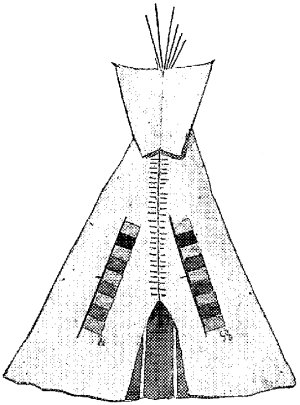 Fig. 310.—[P]ejequde's tent.
Fig. 310.—[P]ejequde's tent.
Since there were no outbuildings, public granaries, or other structures of this description, each household stored away its own grain and other provisions. There were no special tribal or communal dwellings; but sometimes two or more households occupied a single earth lodge. When a council was held, it took place in the earth lodge of one of the head chiefs, or else two or three common tents were united, making one large one.2 There were no public baths, as the Missouri river was near, and they could resort to it whenever they desired. Dance houses were improvised either of earth lodges or skin tents.
Sweat-lodges were in the form of low tents (ʇiuȼipu).3 Stones were not boiled for the sweat-lodge, but were put into the fire to be heated. They were removed from the fire by means of sticks called inߵĕbasiȼan, [Pg 275] and then water from the kettle was poured on them, creating steam. Cedar fronds were dropped on the stones, causing a perfume to arise.
1 Third Ann. Rep. Bur. Ethnology for 1882-'83, p. 230; also "A Study of Siouan Cults," in Eleventh Ann. Rep. Bur. Ethnology, 1889-'90, p. 351.
2 Third Ann. Rep., op. cit., p. 294.
3 Contributions to North American Ethnology, vol. vi, 1890, pp. 152, 169, and 234.
FURNITURE AND IMPLEMENTS.
Fireplaces.
Within the tent, in the center, was the fireplace (uneȼĕ), formed by excavating a small hollow. Beside this was erected a forked post (isagȼĕ), on which was hung the apparatus for suspending a kettle over the fire. This apparatus was called ȼexe uȼugacke by the Ponka, literally, "that by means of which the kettle is hung." The Omaha have two names for it, uhan uȼugacke, and uȼugackegȼe, the last syllable of the latter name referring to the attitude of the post. Around the fireplace was a circular space for the feet of the people as they sat about the fire. The couches of the occupants of the tent were arranged outside of and all around this circular space.
Beds and Bedding.
A couch was formed by laying down two or three winter hides dried with the hair on. These hides were placed around the fireplace at a safe distance. In the earth lodges, according to Joseph La Flèche, the Omaha used sahi, or grass mats, for seats, as is the present custom of the Winnebago; but at night they reclined on dressed hides with thick hair on them, and covered themselves with similar hides.
For pillows they used ibehin or inbehin. When the vegetation was about 3 inches high in the spring, the Indians killed deer and pulled off the hair in order to remove the thin skin or tissue next to it. This latter, when thoroughly dried, is smooth and white, resembling parchment. It was used for pillows and moccasin-strings. When used for pillows the case was filled with goose feathers or the hair of the deer until it was about 2 feet long and 9 inches high. During the day, and whenever there was occasion, they were used as seats; but if none could be had, the people sat on winter robes or hides forming the couches.1 Back of the couches and next to the interior tent-poles were placed the baggage, sacks of corn, and other household properties.
The upright tent is one form of the Dakota "wake′ya," the plural of which, "wake′yapi," undoubtedly gave rise to the familiar "wick′iup" of the plains, and also to "wä-ka′-yo" of Morgan.2
1 Hammocks and bedsteads were unknown prior to their introduction by the traders and other white people.
2 Contributions to North American Ethnology, vol. iv., 1881, p. 114.
Cradles.
A board of convenient size, usually about a yard long and a foot wide, was selected to form a cradle or uȼuhe. No pillow was needed. A [Pg 276] soft skin ([p]aqȼuqaha ȼan) covered with plenty of thick hair was laid on the board, and on it was placed the infant.
 Fig. 311.—Omaha cradle—plan.
Fig. 311.—Omaha cradle—plan.
In the annexed figures, a is the ĭnduaȼisinkanhe, the object painted on the board at the end where the infant's head is laid; b is the ĭndeiȼidĭndin ("that which is drawn taut over the face"), the two strings of beads and sinew or thread (sometimes made of red calico alone), which keep in place the fan, etc.; the fan (ĭndeagani), which is suspended from a bow of wood, (c) is about 6 inches square, and is now made of interwoven sinew on which beads have been strung. Occasionally thimbles and other bright objects dangle from the bottom of the fan. The iȼaȼistage (d) is the band by which the infant is fastened to the cradle.
 Fig. 312.—Omaha cradle—side view.
Fig. 312.—Omaha cradle—side view.
Children's Swings.
For swings the ends of two withes of buffalo hide were secured to four trees or posts which formed the corners of a parallelogram. A blanket was thrown across the withes and folded over on them. The infant was laid on top of the fold and swung from side to side without falling.
Brooms.
Brooms were of two kinds. One form was made of sticks tied together, and was used for sweeping the ground outside of the tent or earth lodge, and the interior of the earth lodge, except the fireplace. The other kind was made of goose or turkey feathers, and was used for sweeping the fireplace of an earth lodge.
Pottery.
Pottery has not been made by the Omaha for more than fifty years. The art of making it has been forgotten by the tribe.
Mortar and Pestles.
A mortar was made by burning a large hole in a round knot or piece of wood about 7 inches in diameter. The lower end was sharpened [Pg 277] to a point, which was thrust into the ground when needed for use. After putting corn in a mortar of this description, the woman grasped the wooden pestle in the middle, with the larger end upward; the smaller end, which was about an inch in diameter, was put into the mortar. The operation of pounding corn among the Omaha was called "he." The mortar (uhe) and pestle (wehe) were both made commonly of elm, although sometimes they were fashioned of white oak. Mortars were of various sizes, some of them measuring 2 feet in diameter. Pestles were always of hard and heavy wood, and fully 3 feet long, taperring from 4 inches to an inch in diameter.
 Fig. 314.—Omaha pestle.
Fig. 314.—Omaha pestle.
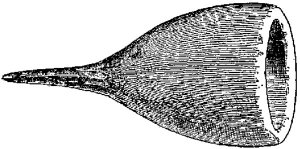 Fig. 313.—Omaha mortar.
Fig. 313.—Omaha mortar.
Spoons, Ladles and Drinking Vessels.
Spoons were made of horn, wood, or pottery. The black spoons made of buffalo horn (ʇehe sabĕ), are not used by such Omaha as belong to the Buffalo gentes (Iñkesabĕ, Ȼatada, [T]esinde, etc.) which may not touch a buffalo head. Other horn spoons of light color are made of cow horn. These are of modern origin. Wooden spoons (janʇehe) were made of knobs or knots of trees. Spoons made of buffalo horn are found among the Omaha and Ponka, but the Osage, Kansa, and Kwapa use clam shells (ʇihaba, in Ȼegiha; tcühaba, tcühuba, in Kansa), so the Kansa call a small spoon, tcühaba jiñga. Spoons of buffalo horn had their handles variously ornamented by notches and other rude carving, often terminating in the head of a bird, the neck or handle of each being elevated at an angle of 50° or 60° with the bowl, which, was about 3 inches in width by about 5 in length. As the handle of such a spoon usually terminates in a head or hook, it was impossible for it to slip into the bowl when the hook rested on the outside of the rim of the bowl.
Food was served in bowls of a very wide and simple form and of various sizes, generally carved out of large knots of wood. These served as drinking cups (ni′iȼátan), but now cups of tin or earthenware are used for that purpose.
Water Vessels
When pottery was made, they used bowls and kettles. Some used wooden bowls of different sizes, the largest being about 2 feet in diameter. When they went on the hunt, they used the ínijeha (or sack made of the muscular coating of the buffalo paunch, by filling [Pg 278] with, grass to make it stand out and keep its shape until dried). When the ínijeha was filled with water the mouth was tied, and it was kept covered and in the shade that it might remain cool. After being used for a few days it became strong smelling, and was thrown away, another taking its place. Some preferred the "ʇenăn′de uqȼa′ha ȼan" or pericardium(?) of the buffalo, which is like sinew. This does not smell unpleasant, even when used for seven or ten days. But at the expiration of that time it is unfit for further service.
Jugs have been introduced by the traders.
Other Vessels.
Provision sacks or parflèche cases were made of dried buffalo hide. When used for carrying the dried meat, they were called weábastá. After two or three years' use they became soft and were fit only for making moccasin soles. These sacks had the hair taken off, and were sometimes made in trunk fashion.
Fruit baskets were of three kinds. The Ponka made them of the bark of a tree, called tawáߵanhe, which is found on the old Ponka reservation in Dakota. Northern Indians make boats of this bark. The Omaha do not find the tree on their land, so they make the fruit baskets of other kinds of bark. The three kinds of baskets are as follows: Nan′pa úȼisĕ, used for chokecherries; agȼañ′kamañge úȼisĕ, used for raspberries; and bact úȼisĕ, used for strawberries. When the Ponka wished to make the baskets, they stripped off the bark in horizontal sections, not pulling upward or downward.
In modern times the Omaha have learned to make sacks of thread of different colors drawn from black, red, blue, and white blankets. Different figures are woven. Each sack is about a foot deep, 16 inches from the mouth to the opposite side, and from 2 to 2-1/2 feet long. The opening is on one of the long sides, and when the articles are put in a gathering string is drawn and tied.
Hoes and Axes.
For hoes, the Omaha used the shoulder blades of the buffalo. Axes and hatchets are now made of iron, hence, the Omaha name, man′ze-pe, sharp iron. But the Kansa have the ancient name, man′hi-spe, answering to the Dakota, wanhin′-kpe, sharp flint. The hatchet is distinguished from the ax by adding "jiñga," small. Some of the stone axes and hatchets have been found on the Omaha reservation, but they could hardly have been used for cutting. It is not known what tools were used for felling trees.
Knives.
Knives were made of stone. A prominent butte, near the old Ponka agency, Nebraska, is known as "Máhin-ʇu," signifying blue knife, from the character of the stone with which its surface is covered. It is [Pg 279] several miles from the mouth of Ponka creek and nearly opposite the month of Choteau creek, South Dakota.
Implements Connected with Fire.
In former ages, the Ȼegiha made fire by rubbing or turning a stick round and round between the hands. On the present Omaha reservation, and in that region, the Omaha use elm roots for that purpose. In the country called [P]izábahéhe, near the source of Elkhorn river, there is a grass known as "duáduáhi," which has about a hundred fine shoots from each root, which is half the size of the head. The stalk was used for hand drills and fire sticks. One stalk was cut almost flat, and the man puts his feet on the ends to steady them. Then, holding the other stick in his hands, with one end touching the stalk on the ground, he turned it round and round till the friction produced fire. Sometimes a small quantity of dry sand was placed on the flat stick. The same flat stick answered for several occasions. When the cavity made by turning the hand drill became too large, the point of contact was shifted to another part of the flat stick, and so on until the whole of that stick was used, when it was thrown away and another was obtained. Duáduáhi, according to Mr. Francis La Flesche, may be found in Judiciary square, Washington, District of Columbia. After the coming of the white man, but before the introduction of friction matches, which are now used by the whole tribe, the Omaha used flints and tinder for making fire.
Spits for roasting, etc., náqpe, or wébasnan, were made of any kind of wood.
For tongs they used the [p]ediȼaȼisande ("fire-holder"), made by slitting one end of a stick. This implement was also called, jan jiñga nini ibista ("the stick that presses the fire against the tobacco"), because it was used for lighting pipes.
Smoking Paraphernalia.
 Fig. 315.—Omaha calumet
Fig. 315.—Omaha calumet
The pipes in use among the Omaha are of three kinds: the sacred pipe (niniba waqube, mysterious pipe), including the war pipes and those used by the chiefs in making peace; the niniba weawan or calumet (illustrated in figure 315), used in the calumet dance or dance of adoption,1 and the hatchet pipe or manzepe niniba, introduced since the coming of the white man. One form of the pipe used on ordinary [Pg 280] Tobacco pouches (niniújiha) were made of deer or antelope skin, and were ornamented with porcupine quills or a fringe of deerskin. Sometimes buffalo bladders were used for this purpose. The women used them as receptacles for their porcupine quills.
occasions is shown in figure 316. This pipe has a bowl of catlinite, and the stem is decorated with horsehair.
 Fig. 316.—Omaha pipe used on ordinary occasions.
Fig. 316.—Omaha pipe used on ordinary occasions.
1 See "Omaha Sociology," Third Ann. Rept. Bur. Ethnology, chap. vi.
Equipage for Horses.
Saddles (cánakágȼe) were in use before the coming of the whites. They were made of wood, around which was wrapped hide, while still "ʇaha-nuʞa" (green or soft). According to Joseph La Flèche these saddles did not rub sores on the backs of the native horses (Indian ponies), but Dougherty1 said, in 1819, "The Indians are generally cruel horse-masters, perhaps in a great measure through necessity; the backs of their horses are very often sore and ulcerated, from the friction of the rude saddle, which is fashioned after the Spanish manner, being elevated at the pummel and croup, and resting on skin saddle cloths without padding." They ride very well, and make frequent use of the whip and their heels, the latter being employed instead of spurs.
For bridles and halters they used strips of hide, out of which material they made also lariats. The bridle used consisted of a withe, one end of which was wrapped two or three times around the animal's lower jaw, while the other was held in the hand, forming but a single rein. This did not hinder the rider from guiding his horse, as he was able to turn him to the left by pressing the single rein against the animal's neck, as well as by the use of the right heel against its side. When he wished to turn to the right, he pulled the rein and pressed his left heel against the horse's side.
Whips were of three kinds. The wahí wégasapi was attached to a bone handle. The handle of a jan′ukeȼin wégasapi was made of common wood. That of a zanzí wégasapi was made of Osage orange wood, which is very hard. The whip was attached to the wrist by a broad band, which passed through a hole near the end of the handle. The handle was about 15 inches long and was very stout. A specimen that has been deposited in the National Museum (a gift to the author from an Omaha) has a lash 2 feet long, composed of 8 thongs one-fifth of an inch wide. These are plaited together in one rounded plait for 18 inches, the rest of the lash being in 2 plaits of 4 thongs each, knotted near the ends.
The lasso was called man′tanah-íȼize, i.e., "that by which (a) wild (horse) is taken." It was made by taking the hair from the head of [Pg 281] a buffalo and plaiting it into a very strong rope as thick as one's thumb. This rope was called "ʇaha-ȼisan," and was utilized by the Omaha and Ponka instead of the common lasso for catching wild horses in northwestern Nebraska. One end of the rope was formed into a noose large enough to slip over a horse's head, and the ends of this noose were secured to a long pole by small cords. The other end of the rope, arranged in a coil, was fastened to the belt or waist of the man. He rode with the pole held in one hand and tried to thrust the noose in front of a horse. When he succeeded in passing the noose over the head of an animal, he threw away the stick, which had become separated from the noose, and held the rope alone, which he pulled toward him. When the horse was caught, the man made an ĭndúȼicin. (bridle or face cover), being careful to place some buffalo hair over the nose and under the chin, to guard against paining the horse, whose eyes remained uncovered.
Trappings for the saddle (sĭn′de-ehéȼĕ) were used. Some years ago a specimen of Omaha trapping was presented by the writer to the Anthropological Society of Washington, and subsequently was deposited in the National Museum.
1 Long, S. H.; Exp. Rocky Mts., vol. 1, p. 291, Phila., 1822
Traveling Gear.
Snow-shoes (sé-hinbe) were worn by the Omaha and Ponka when they traversed a region, north of their modern, habitat.
For traveling on foot a staff (hí-mañgȼe) was used when it was necessary to pass over mountains; also when, heavy loads had to be carried. This staff differed from the crutch (í-mañgȼe).
The women had mácaʞa^n, or straps, for aiding them in carrying loads of wood, etc.
Boats.
When they wished to cross streams they made hide boats, or mandéha. These were manufactured from dried buffalo hides, which were sewed together with sinew, and so tightly that no water could penetrate the seams. Ten branches of red willow were placed within, the ends being bent upward and fastened by withes to two other saplings, which extended the whole length of the boat at the inside of the gunwale. The ten pieces were the ʇíci-íki[p]ádan. The rudder or steering oar (íȼisan′ȼĕ) was fashioned like the oars (mandúȼugáhi), with the blade flat and of the breadth of two hands. The rowers (uȼúgahi aká) sat near the bow, and the steersman (ȼisan′ȼa aká) took his seat at the stern.
Musical Instruments.
Battles were of five kinds, [P]exe were generally gourds; watan′ [p]exe, gourd rattles, were always round, and were partially filled with seed, fine shot, or gravel, [T]ahánuʞa [p]éxe, green-hide rattles, were of two sorts, one of which is "ȼigúje," bent a little. Specimens of this form are in the National Museum.
Two kinds of rattles were called ʇa-cáge, i.e., "deers-claws," from the composition of one variety, though the other was made of molars of the elk.
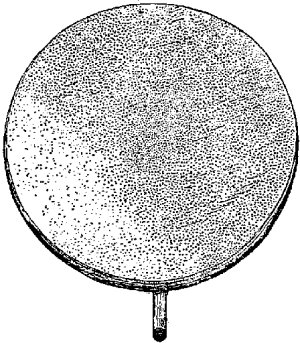 Fig. 317—Skin drum.
Fig. 317—Skin drum.
The Omaha used three styles of drums. The ȼéxe-gaʞú bȼáska, or flat drum, is illustrated by a specimen (no. 21675) in the National Museum. The ȼéxe-gaʞú gadáje is made of buffalo hide, cowhide, or the skin of a horse. An example of this drum (no. 24682) is also in the National Museum, and is illustrated by the accompanying figure 317. The jan′ ȼéxe-gaʞú, or ʞúge ȼéxe-gaʞú, is a wooden or box drum, represented by the accompanying figure 318, also from a specimen (no. 58610) in the National Museum.
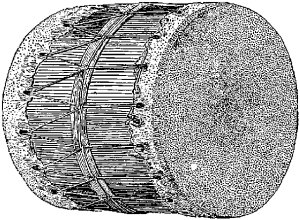 Fig. 318—Box drum.
Fig. 318—Box drum.
Whistles were made of elder (baʇúci-hi, or popgun wood) by pushing out the pith. No holes were made in the sides of the tube.
Nisúde ʇañ′ga, or large flutes, were made of red cedar. A branch was cut off, rounded, split open with a knife, and hollowed out; then six holes were made in the side of one of them, and the halves were stuck together again. When one of these instruments is blown it produces quavering notes. The best specimens were made by [P]áȼin-ʇañ′ga, Big Pawnee.
The large flute is illustrated in figure 319.1 Wahí nisúde, or bone flutes, were made of the long bones from the eagle wing. These small flutes have only one hole. Reed flutes, ȼíqȼe nisúde, were made of a kind of reed which grows south of the Omaha territory, probably in [Pg 283] Kansas. The Omaha obtained the reeds from some of the southern tribes and made them into flutes having but one hole each.
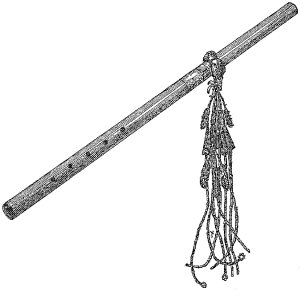 Fig. 319.—Omaha large flute.
Fig. 319.—Omaha large flute.
1 Compare Ree fife, "AMM 129-8429, Gray and Matthews," in the National Museum.
WEAPONS.
Clubs.
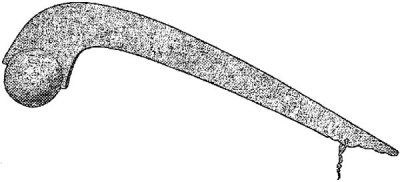 Fig. 320.—Omaha club (jan-[p]áɔna).
Fig. 320.—Omaha club (jan-[p]áɔna).
The jan-wétin, "striking-wood," is a four-sided club. It is made of ash, and is as long as from the elbow to the tips of the fingers. The ja^n-dáona, "wood with a smooth head," is a club made of ironwood, which is very hard. According to the late Joseph La Flèche, the Omaha form of this weapon had a steel point projecting from the ball.
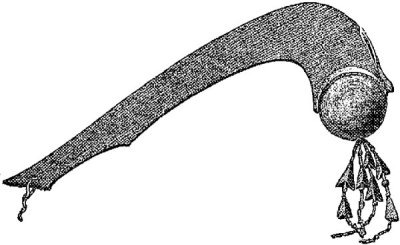 Fig. 321.—Omaha club (jan-dáɔna).
Fig. 321.—Omaha club (jan-dáɔna).
Figures 320 and 321 are forms of the jan-[p]áɔna which may be seen in the National Museum (nos. 2649 and 22419). The weaqȼade, another kind of war club, is made of some kind of hard wood. There are two varieties, one of which is shown in figure 322 (National Museum no. 23729). The other has a ball carved at the end of a straight handle, with a wooden point (of one piece with the ball and handle) projecting from the ball, making an angle of about 130° with one side of the handle. There is a steel point inserted in the ball, forming an angle of about 110° with the other side of the handle. The in′-wate-jiñ′ga is something like a slung shot. A round stone is wrapped in a piece of hide which is fastened to a wooden handle about 2 feet long.
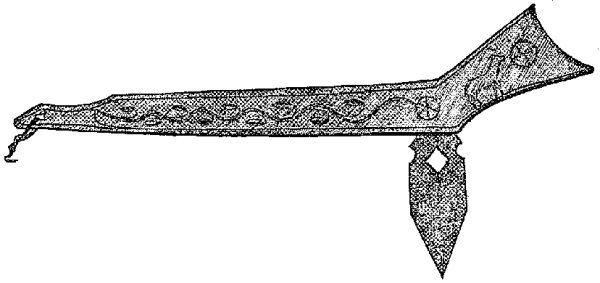 Fig. 322.—Omaha club (weaqȼade).
Fig. 322.—Omaha club (weaqȼade).
Tomahawks.
The heads of tomahawks as well as of battle-axes were at first made of stone; but within the last century and a half they have been fashioned of iron.
Spears.
Lances, darts, or spears are designated by the general term man′dĕhi. The jan′-man'dĕhi are made of ash, and are from 6 to 8 feet long. There [Pg 285] are two kinds, of one of which the handle is round, and about an inch in diameter, and the point is flat and about the width of three fingers at its juncture with the handle.
Besides these there are the lances, called waqȼexe-ȼáze, of which there are two varieties. One consists of a straight pole, which has been thrust through a piece of buffalo hide that has its long end sewed together, forming a sort of covering. To this hide are fastened feathers of the crow and min′xa-san, or swan, in alternate rows or bunches. Between the feathers are fastened square pieces of blanket. About the middle of the pole a space of nearly 6 inches is left without feathers, and this is the place where the spear is grasped. When the pole was not set into a metal point the lower end was cut very sharp.1 The other variety, or mandĕhi ȼiguje, "bent spear," is the weapon which the Dakota call "wahukeza." It is ornamented with eagle feathers placed at intevals, one being at the end of the curved part; and it generally terminates at the bottom in an iron point. It is possible for one of these waqȼexeȼaze to reach a man about 6 feet distant; and even mounted men have been killed by them. Spears are used also in some of the dances. Around the shaft is wrapped the skin of a swan or brant. The end feather at the top is white; the other feathers are white or spotted. The bent spear is no longer employed by the Omaha, though the Osage, Pawnee, and other tribes still use it to a greater or lesser extent.
1 See First Annual Report of Bureau of Ethnology, 1879-'80; 1881, Pl. X, "Tolkotin cremation."
Bows.
 Fig. 323.—Omaha bow (zanzi-mandĕ).
Fig. 323.—Omaha bow (zanzi-mandĕ).
 Fig. 324.—Omaha bow (ʇaʞan-mandĕ)
Fig. 324.—Omaha bow (ʇaʞan-mandĕ)
Bows (man-dĕ) are of two kinds. One is the man-dĕ or zanzi-mandĕ (bow-wood bow), having an unbroken curve past the grip to within an inch or two of each nock.2 The other kind is the ʇaʞan-mandĕ, so called because it has deer sinew glued on its back.3 Bows were made of hickory, ash, ironwood, or zanzi, the last being greatly preferred. It is a wood resembling that of the Osage orange, with which some persons confound it; but it is black and much harder than the former, the Osage orange wood being yellow, soft, and easily cut. The zanzi is probably that which Dougherty4 called "bow-wood (Maclura aurantiaca of Nuttall)."
Bowstrings were made of the twisted sinew of the elk and buffalo, as among other tribes.
2 This may be the "self-bow" mentioned in the American Naturalist for July, 1886, p. 675.
3 This is the sinew-backed bow above mentioned.
4 Long's Expedition, op. cit., vol. I, p. 290.
Arrows.
 Fig. 325.—Omaha hunting arrow.
Fig. 325.—Omaha hunting arrow.
The arrows (man) used in former days were of several kinds. The hunting arrow, used for killing the buffalo, was generally about 2 feet long, of the usual cylindric form, and armed with an elongate triangular point, made at first of flint, afterward of sheet iron. The shoulders of the arrow were rounded instead of angular, as in the ordinary barbed form. The point, or head, was firmly secured to the shaft by deer sinew wrapped around the neck of the point, and over that was spread some cement, made in a manner to be afterward explained. The flight of the arrow was equalized by three half-webs of feathers, neatly fastened near its base in the usual manner.
Another kind of hunting arrow was the hidé nazíȼĕ, which was altogether of wood. About 6 inches from the point the shaft was triangular or quadrangular; and the point was made by holding the shaft close to a fire and turning it round and round till the heat had reduced it to the proper shape and had hardened it. This was used for killing fish, deer, and small game.
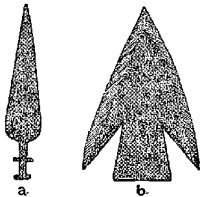 Fig. 326.—Omaha war arrow.
Fig. 326.—Omaha war arrow.
The war arrow (b) differed from that used in hunting in having a barbed point, which was very slightly attached to the shaft, so that if it penetrated the body of an enemy it could not be withdrawn without leaving the point in the wound.
Children used the hidé-ʇece, or target arrow, when they began to learn the use of the bow. With this a boy could kill small birds and animals.
The Ponka used to make arrowshafts (mansa) of jan-′qude-hí, "gray wood," juneberry wood, which grew in their country, but is not found among the Omaha. Most of the Omaha made their shafts of the manʹsaqtihí, or "real arrow-wood," (Viburnum) as that was the wood best suited for the purpose. Sometimes they were made of chokecherry wood; and Joseph LaFlèche informs me that he has made them of ash and hickory.
Arrowshafts were held lengthwise directly in a line with the eyes of the workman, who sighted along them to see if they were straight. If one was bent, he held one end of it between his teeth, while he pressed against the rest of it with his hands. They were polished by means of the polishers, or man′-ȼiqȼáde, two pieces of sandstone, each of which had [Pg 287] a groove in the middle of one side. These grooves were brought together, and the arrow was drawn between them.
War arrows had crooked lines drawn along the shafts from the points to the other ends, down which, so I was informed by the Indians, it was intended that the blood of a wounded foe should trickle.
Arrowheads (máhin-sí), when made of flint, as at the first, were called "in′ߵĕ mahinsí," stone arrowheads. In more recent times, they were manufactured of pieces of sheet iron; as, for example, hoops of pails and barrels.
Arrow cement (hin′pa), for attaching the heads to the shafts, was usually made from the skin taken off a buffalo or elk head. This was boiled a long time, till ready to fall to pieces. When the gelatinous matter forming the cement rose to the top of the water, a stick (called hinpá-janjiñ′ga) was thrust in and turned round and round, causing the material to be wrapped around it. When cooled it was smoothed with the hand. Then the act was repeated till a large quantity was collected on the stick. When needed for use, it was warmed by placing either in the mouth or in hot water. The skin of the big turtle was also used for making cement.
A set of arrows were called, collectively, "manwin′dan." A set generally consisted of ten arrows, but the number varied; sometimes there were two, four, or even twenty. When a man had arrows left in his quiver, he compared them with that which was in the slain animal. When he had none left, he appealed to some one who knew his style of arrow.
There were no clan or gentile marks on arrows. One set was distinguished from another by the order of the paint stripes on them, by the kind of feathers used, by the mode in which the arrowheads were made, etc. The Oto made bad arrows; those of the Pawnee were better, but they were inferior to those made by the Dakota, Ponka, and Omaha.
The feathers, half-webs generally, put on arrows were those of the eagle, buzzard, wild turkey, great owl, and goose. Sometimes hawk or crow feathers were employed.
Quivers.
Quivers (man′jiha) for men were made of buffalo hide; but boys' quivers were made either of otter skins or of the skins of cougars, with the tail of the animal hanging down from the upper extremity. A skin case was attached to the quiver for carrying the bow when not in use. The wrist was defended from the percussion of the bowstring by the leather wristguard or áqande-[p]a.
Shields and Armor.
Shields (ʇaháwagȼe) were made of the hides of buffalo bulls. They were round and very thick, reaching to the waist of the bearer. Arrows did not penetrate them. Joseph La Flèche never heard of the use of defensive armor, such as helmet and mail, among the Omaha and Ponka.
He had heard of a Pawnee who made a coat from four elk skins, two forming the front and two the back. Between each pair of skins was placed sand. A helmet was made in like manner. It covered the back of the head and extended over the forehead, coming down as far as the eyes. When the Pawnee noticed an arrow coming toward him, he bowed his head forward.
Firearms.
Firearms were introduced among the Omaha prior to 1819, when Dougherty says that they preferred those called "Mackinaw guns."
INDEX.
| Armor, Absence of, among the Omaha | 287 |
| of the Pawnee | 288 |
| Arrows of the Omaha | 286 |
| Axes, of the Omaha | 278 |
| Bark, Omaha lodges of | 269, 271 |
| Basketry of the Omaha | 278 |
| Baths, public, Absence of, among the Omaha | 274 |
| Beds and bedding of the Omaha | 275 |
| Big Pawnee, Flutes made by | 282 |
| Bikúde, an Omaha village | 270 |
| Bladders used as receptacles | 280 |
| Boats of hide of the Omaha | 281 |
| Bone hoes of the Omaha | 278 |
| Bridles of the Omaha | 280 |
| Brooms of the Omaha | 276 |
| Buffalo, gents of the Omaha | 277 |
| Ȼegiha fire-making | 279 |
| Cement used by the Omaha | 287 |
| Children, Omaha, Target arrows of the | 286 |
| Clubs, War, of the Omaha | 283 |
| Couches of the Omaha | 275 |
| Cradles of the Omaha | 275 |
| Dakota, Arrows of the | 287 |
| Dance houses of the Omaha | 274 |
| Decoration of Omaha tents | 274 |
| Dorsey J. O., on Omaha dwellings, furniture, and implements | 263-288 |
| Dougherty, —, on Omaha bow-wood | 285 |
| firearms | 288 |
| horse equipage | 280 |
| Drilling, with grass-stalks | 279 |
| Drinking vessels of the Omaha | 277 |
| Dwellings, furniture and implements of the Omaha | 263-288 |
| Equipage for horses | 280 |
| Firearms among the Omaha | 288 |
| Fire implements of the Omaha | 279 |
| Fireplace in Omaha lodge | 271 |
| of the Omaha and Ponka | 275 |
| Flute of the Omaha | 282 |
| Furniture, dwellings, and implements of the Omaha | 263-288 |
| Gentile marks, Absence of, on Omaha arrows | 287 |
| Grain, Storage of, among the Omaha | 274 |
| Halters of the Omaha | 280 |
| Hammocks introduced among the Omaha | 275 |
| Hoes, Bone, of the Omaha | 278 |
| Horn spoons of the Omaha | 277 |
| Implements of the Omaha | 263-278 |
| Iowa indians, Bark lodges of | 271 |
| Janȼa′te, an Omaha village | 270 |
| Kansa, Lodges of the | 270 |
| Knives of the Omaha | 278 |
| La Flèche, Joseph, on Omaha armor | 287 |
| arrowshafts | 286 |
| mats | 275 |
| saddles | 280 |
| war-clubs | 283 |
| La Flesche, Francis, on grass-stalk drills | 279 |
| Lances of the Omaha | 285 |
| Lariats of the Omaha | 280 |
| Lodges of earth, Use of | 271 |
| , Omaha, how constructed | 269 |
| Long, S. H., on Kansa lodge | 269 |
| Omaha bow-wood | 285 |
| indian horsemanship | 280 |
| Mason, O. T, Acknowledgements to | 269 |
| Mats, cane, the Omaha and Winnebago | 275 |
| , Omaha lodges of | 269, 271 |
| Mortars of the Omaha | 276 |
| Musical instruments of the Omaha | 281 |
| Omaha dwellings, furniture and implements | 263-288 |
| Osage indians, Bent spear used by | 285 |
| , Lodges of, described | 285 |
| Oto, Arrows of the | 287 |
| Pawnee, Armor of the | 288 |
| , Arrows of the | 287 |
| , Bent spear used by the | 285 |
| [P]ejqude, Tent of | 273, 274 |
| Pestles of the Omaha | 276 |
| Pillows of the Omaha | 275 |
| Pipes of the Omaha | 279 |
| Ponka, Armor not used by the | 287 |
| , Arrows of the | 287 |
| dwellings, furniture and implements | 269 |
| , Ropes of the | 281 |
| Pottery, formerly made by the Omaha | 276, 277 |
| Provision sacks of the Omaha | 278 |
| Quivers of the Omaha | 287 |
| Riding, Omaha method of | 280 |
| Sacks of the Omaha | 278 |
| Saddles of the Omaha | 280 |
| Sanssouci, Village of | 271 |
| Sauk, Bark lodges of the | 271 |
| Say, T., on Kansa lodge | 269 |
| Sewing among the Siouan tribes | 274 |
| Shields of the Omaha | 287 |
| Skin lodge of the Omaha | 269, 271 |
| Smoke holes of Omaha lodge | 273 |
| Smoking paraphernalia, Omaha | 279 |
| Snow-shoes, Omaha and Ponka | 281 |
| Spears of the Omaha | 284 |
| Spoons of the Omaha | 277 |
| Standards, War, of the Omaha | 273 |
| Standing Hawk Village of | 270 |
| Stone arrowheads of the Omaha | 287 |
| axes of the Omaha | 278 |
| knives of the Omaha | 278 |
| Sweat-houses of the Omaha | 274 |
| Swings of Omaha children | 276 |
| Tobacco pouches of the Omaha | 284 |
| Tomahawks of the Omaha | 284 |
| Tongs of the Omaha | 279 |
| Totem posts, Absence of, among the Omaha | 274 |
| Traveling gear, Omaha and Ponka | 281 |
| Utensils of the Omaha | 277 |
| Water vessels of the Omaha | 277 |
| Weapons of the Omaha | 283 |
| Whips of the Omaha | 280 |
| Whistles of the Omaha | 282 |
| Wickiup, Origin of term | 275 |
| Winjage, an Omaha village | 270 |
| Winnebago grass mats | 275 |
| lodges described | 271 |
| Women, Omaha lodges made by | 269 |
| Wood, Spoons of, of the Omaha | 277 |
| Wristguards, of stone used by the Omaha | 287 |
| Yellow Smoke, Earth lodge of | 270 |